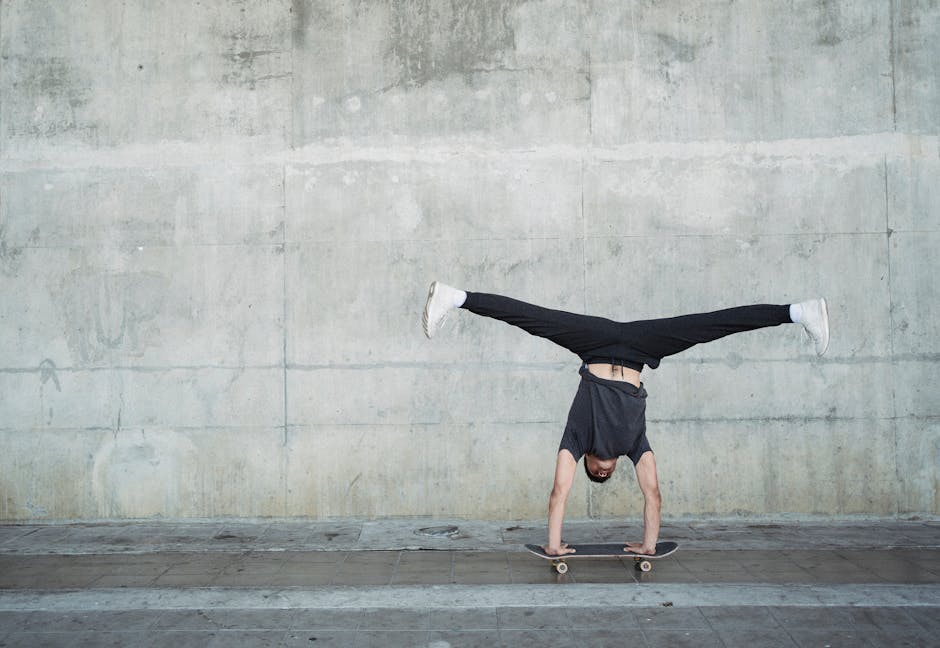Tried the HARDEST Stunts From Anime IN REAL LIFE: A Journey Into the Fantastic (and Slightly Dangerous!)

Tried the HARDEST Stunts From Anime IN REAL LIFE: A Journey Into the Fantastic (and Slightly Dangerous!)
Konnichiwa, design-loving friends! Today, we're not discussing the subtle beauty of minimalist Japanese interiors or the perfect placement of a single bonsai tree. Instead, we're diving headfirst (sometimes literally) into something a little…different. We're talking anime stunts. Yes, those gravity-defying, physics-mocking feats of agility and strength that we watch with wide-eyed wonder. I, ever the curious experimenter, decided to see how some of the hardest anime stunts translate into the real world. Spoiler alert: reality is often less forgiving than animation.
The Allure of Anime Stunts: More Than Just Spectacle

Before we get into the inevitable bruises and near-misses, let's acknowledge why we're drawn to these impossible acts in the first place. Anime stunts, much like Japanese art forms in general, are often rooted in a deep sense of aesthetics and narrative. They aren't just random displays of power; they tell a story, express a character's determination, and often, even their vulnerability. Think about it – the intricate swordplay in Samurai Champloo speaks volumes about the characters' personalities and their unique fighting styles. Or the parkour sequences in Soul Eater, which visually represent the characters' agility and teamwork.
It's not just about the "wow" factor, though that's definitely a part of it! The exaggerated nature of anime allows for a visual representation of inner strength and resilience that resonates with us. It's a projection of our own desires to overcome obstacles, to push our limits, and to achieve the seemingly impossible. And let's be honest, who hasn't secretly wanted to leap across rooftops like a ninja?
Safety First (Because Anime Characters Don't Always Prioritize It)

Now, before anyone attempts what you're about to read, let me emphasize this in bold: I am not a professional stunt person. I am a design enthusiast with a slightly reckless curiosity. I took precautions where possible, which included stretching thoroughly (very important!), researching the mechanics behind the stunts, and, in some cases, using mats or asking a friend for assistance. Please, please, please do not try these without proper training and supervision. A broken leg is not a chic accessory.
Stunt #1: The Wall Run (Attack on Titan Style…Sort Of)

The Anime Inspiration: The Survey Corps in Attack on Titan are masters of the wall run, using their ODM gear to propel themselves upwards. While ODM gear is sadly not yet a reality (patent pending, perhaps?), the basic principle of a wall run is theoretically achievable.
The Reality Check: My initial attempts were… less than graceful. I pictured myself scaling a wall with the speed and precision of Mikasa Ackerman. The reality involved a lot of awkward shuffling, scraped knees, and the dawning realization that anime characters have an unfair advantage in terms of superhuman strength and balance.
Here's what I learned:
- Approach is Key: You need a running start to generate momentum. The angle of approach is crucial; too shallow, and you'll just scrape against the wall. Too steep, and you'll faceplant.
- Foot Placement: Aim for a spot that gives you enough purchase to push off. Finding the right angle for your foot is crucial. I found that a slightly angled placement helped me generate upward force.
- Upper Body Strength: This is where I failed spectacularly. Anime characters make it look effortless, but maintaining upward momentum requires significant upper body strength to pull yourself up.
- Practice, Practice, Practice: After many attempts (and a few embarrassing tumbles), I managed to achieve a few steps up the wall. It wasn't exactly Survey Corps level, but it was progress!
The Verdict: Possible, but requiring serious dedication and training. I admire the Titan slayers even more now.
Stunt #2: The Mid-Air Dodge (Naruto-Inspired Agility)

The Anime Inspiration: Naruto Uzumaki and other skilled ninjas are masters of mid-air dodges, often twisting and contorting their bodies to avoid projectiles or attacks. It's a staple of action anime, and looks incredibly cool.
The Reality Check: I envisioned myself gracefully evading an imaginary kunai, twisting my body with the flexibility of a seasoned ninja. The reality was… a slightly panicked jump followed by a rather clumsy attempt to reorient myself. I quickly understood that simply jumping wasn't enough.
Here's what I discovered:
- Core Strength is Your Friend: A strong core is essential for maintaining balance and control in the air. This is where pilates and yoga proved surprisingly helpful.
- Spatial Awareness: Knowing where your body is in relation to its surroundings is crucial. This is more about developing instinct than anything else.
- Small, Controlled Movements: Instead of flailing wildly, focus on small, controlled movements to adjust your trajectory. Think about shifting your weight slightly to change direction.
- Start Small: Don't try to dodge anything actually dangerous at first. Practice with a soft object thrown gently or simply visualize the dodging scenario.
The Verdict: While I didn't quite reach Naruto levels of agility, I did improve my spatial awareness and core control. I even managed to dodge a few playfully thrown pillows with a semblance of grace. It's a skill that, surprisingly, has come in handy navigating crowded streets!
Stunt #3: The Dramatic Jump and Landing (Shonen Anime Standard)

The Anime Inspiration: From Dragon Ball Z to One Piece, nearly every shonen anime features characters leaping from great heights and landing with a dramatic flourish. Often, they're completely unscathed.
The Reality Check: This one seemed deceptively simple. How hard could it be to jump and land? Very hard, apparently. I started with a small jump from a low platform, focusing on controlling the impact. The first few attempts felt awkward and jarring. My knees definitely protested.
Here's the lowdown on safe(r) landings:
- Bend Your Knees: This is the golden rule of landing. Bending your knees absorbs the impact and prevents injury. Imagine you're trying to compress a spring.
- Distribute the Impact: Try to distribute the impact evenly throughout your body. This means engaging your core and keeping your back straight.
- Practice Controlled Falls: Learn how to fall safely. This involves rolling and tucking to minimize the impact on vulnerable areas. (Again, supervised training is highly recommended!)
- Start Low, Go Slow: Don't attempt a dramatic jump from a tall building right away. Start with small jumps and gradually increase the height as you become more comfortable.
The Verdict: Jumping and landing safely is a fundamental skill. I learned to appreciate the importance of proper technique and respecting my body's limits. I'm still working on the dramatic flourish, though. Maybe a cape would help?
Stunt #4: The Sword Catch (Rurouni Kenshin's Impeccable Reflexes)

The Anime Inspiration: Rurouni Kenshin, the wandering swordsman, is renowned for his incredible reflexes, often catching swords mid-swing with his bare hands. This requires incredible precision, timing, and unwavering nerve.
The Reality Check: Let me be clear: I did not attempt to catch a real sword. That would be foolish, even for me. Instead, I used a padded practice sword (bokken) and had a friend gently toss it towards me. Even with these precautions, my initial attempts were… terrifying.
What I learned (while avoiding injury):
- Focus and Concentration: You need to be completely focused on the trajectory of the sword. Any hesitation or distraction can lead to disaster.
- Timing is Everything: The timing of the catch is crucial. You need to intercept the sword at the optimal point in its arc.
- Grip Strength: You need a strong grip to secure the sword once you've caught it. Practice gripping exercises can help with this.
- Gradual Progression: Start with slow, controlled throws and gradually increase the speed as you become more comfortable. And always wear protective gloves.
The Verdict: Even with a padded sword, this stunt is incredibly dangerous and requires extensive training. I gained a newfound respect for Kenshin's skill and the sheer precision required to catch a blade. I'll stick to admiring it from the safety of my screen.
Anime Stunts: A Reflection of Human Potential (and a Healthy Dose of Exaggeration)

While my attempts to replicate anime stunts didn't always go as planned (understatement of the year!), the experience was incredibly insightful. It highlighted the immense dedication, skill, and physical conditioning required to perform these feats, even in their more realistic forms. It also reinforced my appreciation for the artistry and storytelling that goes into anime action sequences.
Ultimately, anime stunts, while often exaggerated, represent a fascination with human potential. They inspire us to push our limits, to strive for excellence, and to believe in the possibility of achieving the seemingly impossible. But perhaps, they're best left to the realm of animation… at least until I acquire ODM gear.
So, what's next? Perhaps mastering the art of the dramatic anime character entrance? Or maybe, just maybe, I'll stick to arranging flowers. Until next time, stay curious, stay stylish, and stay safe! Mata ne!
Post a Comment